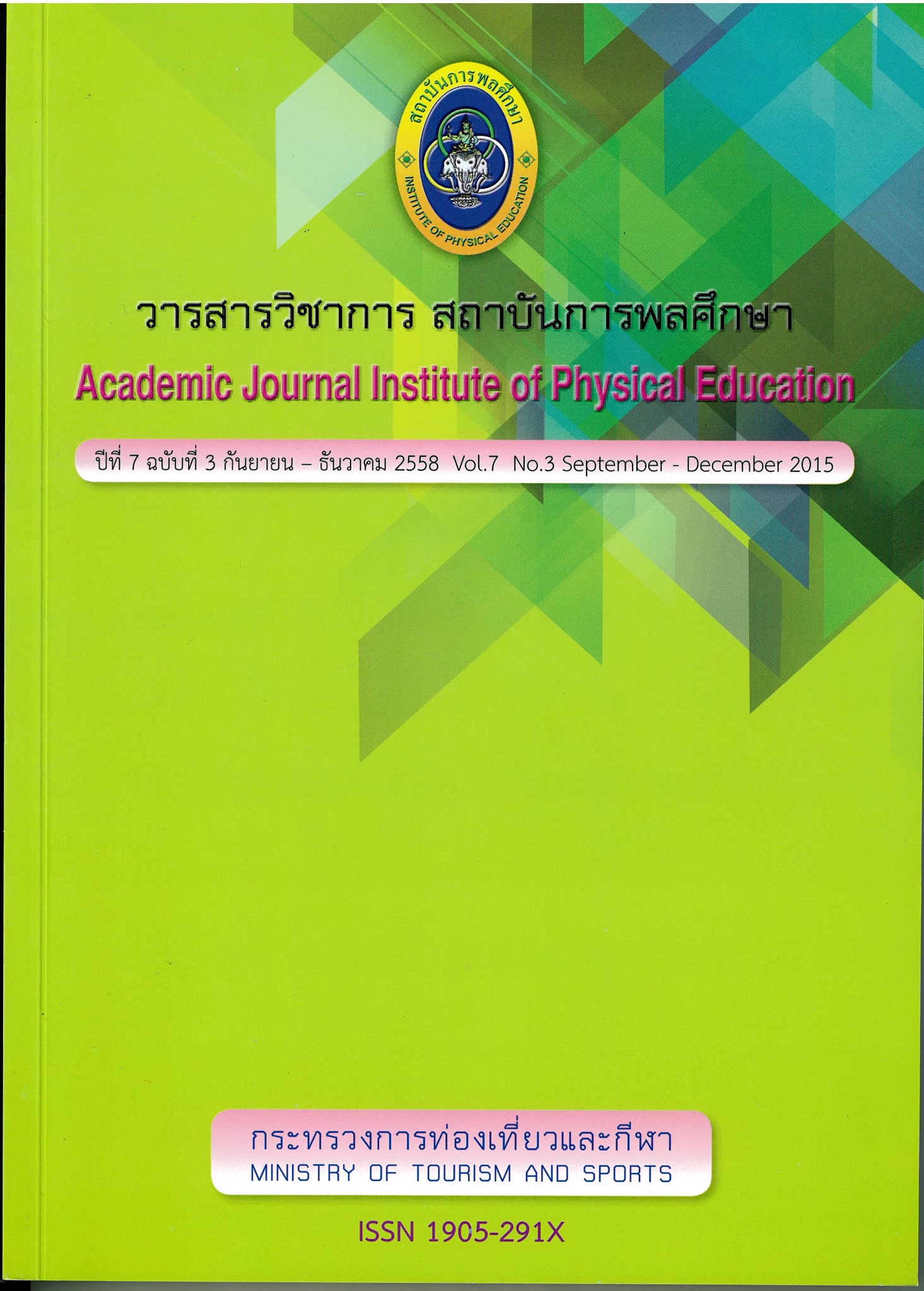Health-Related Physical Fitness Age 16-18 Years Old Students In Yannawatewittayakom School In Academic Year 2014
Main Article Content
Abstract
The purpose of this study aimed to investigate to Health-Related Physical fitness age 16-18 years old students in yannawatewittayakom school in academic year 2014. The subjects of 600 students, by Non-proportional Stratified Random Sampling were 300 male and 300 female. The instrument in this research was Health-Related Physical Fitness test for Thai Students, age 7-18 years old including 7 items which were Body Mass Index (BMI), Skinfold Thickness, Sit-ups 60 seconds, Push-Ups 30 seconds, Sit and Reach, Zig-Zag Run and Distance Run. The data were analyzed by means and standard deviations.
The results were as follows:
- Health-Related Physical fitness of male age 16-18 years of majority in moderate level except physical fitness in the item of Zig-Zag Run in lowest level.
- Health-Related Physical fitness of female age 16 years of majority in low level except physical fitness in the item of Body Mass Index (BMI) in appropriately, 17-18 years of majority in low level except physical fitness in the item of Distance Run in moderate level.
Article Details

This work is licensed under a Creative Commons Attribution-NonCommercial-NoDerivatives 4.0 International License.
The published article is a copyright of the Academic Journal of Thailand National Sports University. The passage appeared in each article in this academic journal is a perspective of each author which is not related to the journal. Each author is required to be responsible for all components of his/her own article. If there are any mistakes, each author must be responsible for those mistakes on his/her own.
References
กรมพลศึกษา สํานักพัฒนาการพลศึกษา สุขภาพ และนันทนาการ. (2539), การทดสอบและประเมินผลสมรรถภาพทางกาย, พิมพ์ครั้งที่ 2. กรุงเทพฯ: กรมวิชาการ,
กระทรวงศึกษาธิการ. (2551). หลักสูตรแกนกลางการศึกษาขั้นพื้นฐาน พุทธศักราช 2551. กรุงเทพฯ: โรงพิมพ์ชุมนุมสหกรณ์การเกษตรแห่งประเทศไทย.
กรรวี บุญชัย. (2540), AAHPERD Health – Related Physical Fitness Test. กรุงเทพฯ: ภาควิชาพลศึกษา คณะศึกษาศาสตร์ มหาวิทยาลัยเกษตรศาสตร์.
เจียมศักดิ์ พานิชชัยกุล และคนอื่นๆ (2549). สมรรถภาพทางกายของนิสิตชั้นปีที่ 1 วิชาเอกพลศึกษา ปีการศึกษา 2545. กรุงเทพฯ: ภาควิชาพลศึกษา มหาวิทยาลัยศรีนครินทรวิโรฒ. ถ่ายเอกสาร.
พงษ์ศักดิ์ ดําขํา. (2550). สมรรถภาพทางกายเพื่อสุขภาพของนักเรียนหญิงชั้นมัธยมศึกษาปีที่ 3 โรงเรียนในเครือคณะภคินีพระหฤทัยของพระเยซูเจ้าแห่งกรุงเทพฯ ในเขตกรุงเทพมหานคร ปีการศึกษา 2549. ปริญญานิพนธ์ กศ.ม. (พลศึกษา), กรุงเทพฯ: บัณฑิตวิทยาลัยมหาวิทยาลัยศรีนครินทรวิโรฒ. ถ่ายเอกสาร.
วันใหม่ ประพันธ์บัณฑิต. (2549), วารสารวิทยาศาสตร์และเทคโนโลยีการกีฬาปีที่ 6. ฉบับที่ 1 เลขหน้า 99-112 ปี พ.ศ. 2549.
วิโรจน์ เจริญยิ่ง และคนอื่นๆ (2549). ปัจจัยที่มีความสัมพันธ์ต่อพฤติกรรมการออกกําลังกายของนักเรียนชั้นมัธยมศึกษาตอนปลายโรงเรียนสังกัดสํานักงานเขตพื้นที่การศึกษาปราจีนบุรี, วารสารคณะพยาบาลศาสตร์, 14(1)23-24.
สํานักงานกองทุนสนับสนุนการสร้างเสริมสุขภาพ. (2549). แบบทดสอบและเกณฑ์มาตรฐานสมรรถภาพทางกายที่สัมพันธ์กับสุขภาพสําหรับเด็กไทย อายุ 7-18 ปี พิมพ์ครั้งที่ 2.
American Alliance for Health, Physical Education, Recreation and Dance. (1988). Physical Best. A Physical Fitness History Education & Asswssment Program. Virginia: Association Drive Boston.
Clark, H.H. (1976). Application of Measurement to Health and Physical Education. (4th ed.). New Jersey: Prentice-hall, Inc.
Su, Chun-Hsien. (1993). Development of Fitness Norms for School-Aged Children in Hsinchu, Taiwan (China). University of Northern Colorado.
Greenberg, J., G. B. Dintiman and B.M. Oakes. (1998). Physical Fintess and Wellness. Boston: Allyn and Bacon.
Looney, M.A., & S.A. Plowman. (1990). Passing Rated of American Children And Youths on the FITNESSGRAM Criterion-Referenced Physical Fitness Standards. Research Quarterly of Exercise and Sport. 61:215-223.


